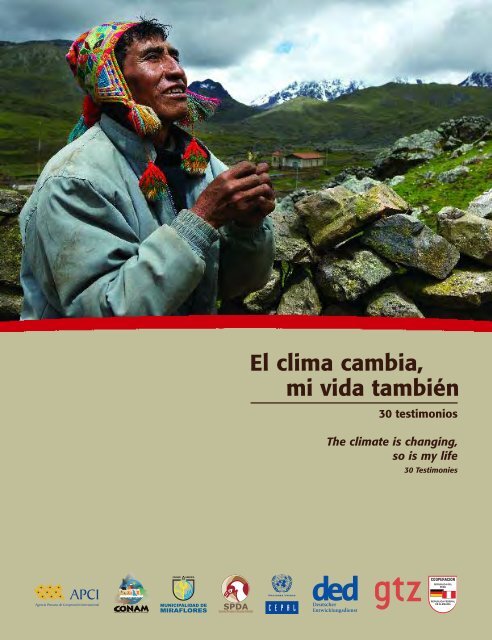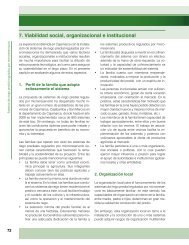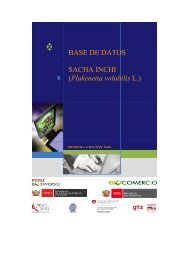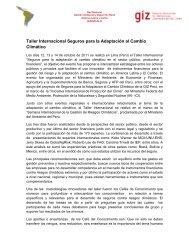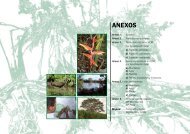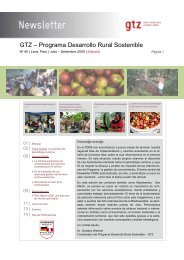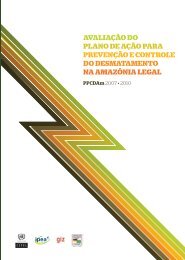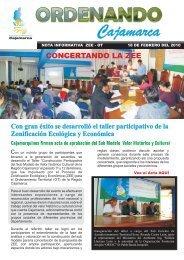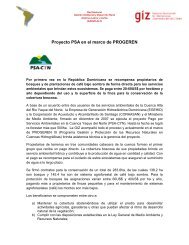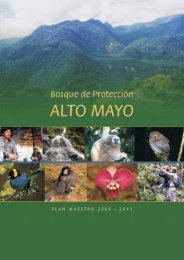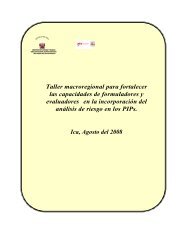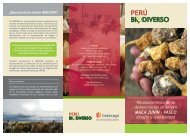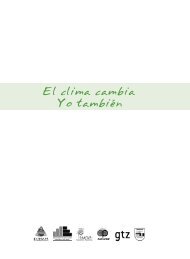You also want an ePaper? Increase the reach of your titles
YUMPU automatically turns print PDFs into web optimized ePapers that Google loves.
<strong>El</strong> <strong>clima</strong> <strong>cambia</strong>,<strong>mi</strong> <strong>vida</strong> <strong>también</strong>30 testimoniosThe <strong>clima</strong>te is changing,so is my life30 Testimonies
“Todo <strong>cambia</strong>, pero desgraciadamentela mente de la gente demora en <strong>cambia</strong>r”.Henry Llerena LlerenaPresidente del Co<strong>mi</strong>té de Regantes de Chila en Arequipa“Everything changes, but,unfortunately, it takes a littlelonger for people’s <strong>mi</strong>ndsto change.”Henry LlerenaPresident of the Chila Community WaterConsumers Board, in the department ofArequipa.
PresentaciónLas anteriores palabras forman parte de uno de los testimonios que dan<strong>vida</strong> a la exposición fotográfica “<strong>El</strong> <strong>clima</strong> <strong>cambia</strong>, <strong>mi</strong> <strong>vida</strong> <strong>también</strong>”, cuyaprimera parada se llevó a cabo del 1 al 31 de mayo de 2008 en el ParqueCentral de Miraflores, Lima, en el marco de la V Cumbre de Jefes de Estadoy de Gobierno de América Latina, <strong>El</strong> Caribe y la Unión Europea (ALC-UE).<strong>El</strong> cambio climático ya es una realidad y, si no reaccionamos, se puedeconvertir en una de las amenazas más grandes para toda la humanidad ynuestra tierra. No se trata de algo lejano, sino que ya está pasando y —algunosmás, otros menos— lo estamos sintiendo en nuestras <strong>vida</strong>s. Estecambio en la <strong>vida</strong> de las personas es lo que la exposición “<strong>El</strong> <strong>clima</strong> <strong>cambia</strong>,<strong>mi</strong> <strong>vida</strong> <strong>también</strong>” pretende hacer visible mediante los testimoniosrecogidos de los propios pobladores peruanos.Esta muestra fotográfica presenta treinta testimonios, tanto de la costa,como de la sierra y de la selva. Sin embargo, estos son solo el punto de partida,pues luego de Lima se pretende llevar la exposición a las tierras dedonde provienen estos primeros testimonios, y seguir recolectando impresiones.La visión es ir completando, paulatinamente, una imagen grande ycada vez más clara: la imagen de cómo el cambio climático impacta demanera negativa, y <strong>también</strong> positiva, a las poblaciones de las diferentes regionesdel Perú y, cómo ellas <strong>mi</strong>smas <strong>cambia</strong>n sus medios de <strong>vida</strong> y costumbrespara adaptarse a esta nueva realidad.Este trabajo se enmarca en un amplio proceso de comunicación y educaciónambiental sobre el tema de cambio climático en el Perú, en el cualse unen los conoci<strong>mi</strong>entos tradicionales con la información científica. Así,partimos del concepto que para lograr un cambio de conducta en la genteIntroductionThe above quotation comes from thetestimonies that breathe life into thephotography exhibition, “The <strong>clima</strong>te ischanging, so is my life”, whose first stopwas Miraflores Central Park in the cityof Lima, from May 1st to the 31st,to coincide with the V Sum<strong>mi</strong>t of Headsof State and government of Latin America,the Caribbean and the European Union(LAC-EU).Climate change is a reality, and, if we donot take action, then it may become thegreatest of all threats to humankind and toour planet itself. Moreover, <strong>clima</strong>te changeis not a prediction for the distant future. Itis happening right now, and all of us – to agreater or lesser degree – are feeling its effectupon our lives. It is this change in people’slives that the exhibition “The <strong>clima</strong>te ischanging, and so is my life” is designed tohighlight and it does this by featuring thetestimonies of ordinary Peruvians.The exhibition of photographs featuresthirty statements from people living in thethree different geographical regions of Peru:the coast, the highlands and the jungle.However, this is just a beginning, for as soon1
es necesario primero conocer sus percepciones. Esta iniciativa se convertirá,de esta manera, en un medio para entender y aprender sobre lo que estápasando en nuestra tierra y en nuestras <strong>vida</strong>s.Con esta publicación queremos que todos aquellos que han tenido laoportunidad de visitar personalmente la exposición y <strong>también</strong> todos aquellosque aún no la conocen se lleven a sus casas las imágenes y vivencias deestos personajes de carne y hueso.Los invitamos a <strong>mi</strong>rar, leer y reflexionar sobre lo que cuentan nuestrostreinta primeros testigos.LOS ORGANIZADORESas the exhibition ends in Lima we planto take it to the areas where the firsttestimonies were gathered and continuethe work of recording the thoughts andwords of ordinary Peruvians. The idea isto gradually produce a single picture fromall the testimonies recorded; an image ofhow <strong>clima</strong>te change is impacting – bothpositively and negatively – on the livesof people living in the different regions ofPeru, and how these individuals arechanging their lifestyles and habits toadapt to their new reality.The frame of reference for this task is awide-reaching process of communicationand environmental education focused onthe issue of <strong>clima</strong>te change in Peru, inwhich traditional and state-of-the-artscientific knowledge complement oneanother. The idea we wish to stress is thatto change people’s habits one must firstunderstand their perceptions. In this way,this initiative will help us all to learnabout and better understand what ishappening to both our land and our lives.Through this publication, we wanteveryone – those who had the chance topersonally visit the exhibition and thosewho did not – to take home with themthe images and experiences of these fleshand blood people.We furthermore invite you to look, read,and reflect upon what our thirty witnesseshave to say.THE ORGANIZERS.2
Javier MacedoPescador de los ríos Madre de Dios y Tambopata“Es maravilloso ver la cantidad y la diversidad de peces que hay en nuestra amazonía.Sin embargo, se está depredando terriblemente todo este territorio. Para criar ganado,los <strong>mi</strong>grantes de la sierra han ‘limpiado’ <strong>mi</strong>llones de hectáreas y están quemandoel bosque. <strong>El</strong>los rompen el equilibrio. Y destrozar este equilibrio tan frágil es destrozarla razón que nos da la <strong>vida</strong>. Están malogrando los pulmones de nuestra tierra”.PUERTO MALDONADO, MADRE DE DIOS (2006)Javier MacedoFisherman on the Madre de Diosand Tambopata Rivers“It is marvelous to see the amount and diversityof fish in our Amazon. Yet, they are beingappallingly plundered throughout this land.In order to raise livestock, <strong>mi</strong>grant farmers havecome from the highlands and ‘cleaned’ <strong>mi</strong>llionsof hectares of land and are burning the forest.They have destroyed the balance of nature. Andto destroy this fragile balance is to destroy the veryessence of our life. They are ruining the lungsof our land.”PUERTO MALDONADO, MADRE DE DIOS (2006)3
Félix Vicencio MaguiñaGuía de montaña en Huaraz“Cuando perforamos los glaciares para tomar pruebas, con frecuencia podemosllegar hasta el nivel de las rocas. Los nevados están muriendo raudamente y pocoa poco se están llevando nuestra alegría. A raíz de esto, los ríos están trayendo nuevamentebastante agua. Sin embargo, esto no ha logrado frenar el éxodo de los saposy las ranas de los valles, que han sido reemplazados por plagas y moscas extasiadaspor las altas temperaturas, en medio de un paisaje en donde la prosperidad es partede los recuerdos nostálgicos de los pobladores”.ABRA PUNTA OLÍMPICA, ANCASH (2008)Felix Vicencio MaguiñaMountain guide from the Huaraz Province“When we drill glaciers to take samples, we oftenreach rock. Our snow capped mountains arequickly dying, and little by little this is strippingaway our joy. As a consequence, water levels inrivers are on the increase, but this has not stoppedtoads and frogs from disappearing from the valleys;now they are being replaced by bugs and flies thatare loving the rise in temperatures, in the <strong>mi</strong>dst ofa landscape where prosperity is one fond memoryof the inhabitants”.PUNTA OLIMPICA PASS, ANCASH (2008)4
Benjamín PalmaceraBuzo frente a la Isla Santa Rosa“Cuando recién comencé de buzo, allá por los 80, había grandes cantidades de conchasde abanico para todos. Era la época del Niño con su agua caliente. Hoy ya nadiesabe si estamos en época de “niño” o “niña”. Tenemos que adaptarnos a lo que tenemos.Algunos días sacamos algas, otros días conseguimos almejas o navajas. En fin, es cosade la naturaleza, que nos da lo que tiene disponible y nos hace cada vez más difícilla extracción de los recursos”.PARACAS, ICA (2008)Benja<strong>mi</strong>n PalmaceraDiver off of Santa Rosa Island“When I began diving, back in the 80’s, therewas a huge amount of scallops to be gotten byeveryone. That was during the <strong>El</strong> Niño and itswarm waters. Today, nobody knows if we are inan <strong>El</strong> Niño or La Niña. We have to adapt towhat is given us. Some days, we get seaweed.Other days, we get ordinary clams or razor clams.Anyway, it has to do with Mother Nature, whogives us what she has available and who ismaking it increasingly more difficult for usto extract her resources.”PARACAS, ICA (2008)5
José Oriel Alta<strong>mi</strong>rano GuerreroFundador de la Asociación de Campesinos Agroecológicos “Mishquiyaquillo”“Nuestros bosques dan <strong>vida</strong> a <strong>mi</strong> ciudad natal y calman la sed de sus habitantes.La ciudad debería de pagar por este servicio ambiental, pues estos son los últimosbosques que tenemos desde donde podemos obtener agua limpia”.MOYOBAMBA, SAN MARTÍN (2007)Jose Oriel Alta<strong>mi</strong>rano GuerreroFounder of the MishquiyaquilloAgro-Ecological Farmers Association“Our forests provide life to my birthplace andsatisfy the thirst of its people. The city shouldpay for this environmental service since theseare the last forests we have where we can obtainclean water.”MOYOBAMBA, SAN MARTIN (2007)6
Máximo Crispín ManduraComunero de la comunidad campesina Ausangate“Cuando se nubla el Ausangate estamos felices y le ofrecemos nuestra coquita. Leagradecemos, pues, que se esté cubriendo nuevamente de nieve. <strong>El</strong> Ausangate guardanuestra agüita que necesitamos para los meses de junio hasta noviembre, parala siembra. Antiguamente comenzaba la lluvia en octubre. Hoy recién empieza endiciembre. Esto no le da tiempo a la papita y la oquita para que maduren. Estamosconstruyendo un canal de riego y rogamos que el apu Ausangate se nos quedecon nieve”.OCONGATE, CUSCO (2008)Maximo Crispin ManduraAusangate far<strong>mi</strong>ng community member“When the clouds gather around the sum<strong>mi</strong>t ofMount Ausangate we are happy and we make anoffering to it of coca leaves. We thank the mountainfor once again blanketing itself with snow. MountAusangate stores the water we need from June toNovember, during the planting season. Before, itused to begin raining in October. These days itstarts in December. This does not give the potatoesor ocas enough time to ripen. We are buildingan irrigation canal and are praying that ourprotector, Ausangate, remains covered with snow.”OCONGATE, CUSCO (2008)7
Luis Ángel García o “Quince” (porque trabaja desde los 15 años)Pescador en Laguna Grande“Antes bastaba con <strong>mi</strong>rar el mar para saber dónde estaba el recurso. Ahora todo esmás difícil. Tenemos que guiarnos por información que vemos en Internet parasaber si habrá neblina o cómo va a estar el viento. Incluso trabajamos con una sondaque busca cardúmenes vía satélite, pero ni eso nos asegura que encontraremos elrecurso. Estamos pensando en ir a trabajar a Mollendo, o quizás al Callao”.PARACAS, ICA (2008)Luis Angel Garcia or “Quince” (15),because he has worked since hewas 15 years oldFisherman from Laguna Grande“Before, it was enough just to look out uponthe ocean to know where the resource was.Now, it is much more difficult. We have to beguided by data we get off the Internet to knowif it will be foggy or windy. We even work withsatellites when searching for schools of fish, butthis is no guarantee that we will find the resource.We are thinking about going to Mollendo orperhaps even Callao to fish.”PARACAS, ICA (2008)8
Antonio NonatoMotosierrista“Aquí en Iñapari, en la Maderija y Maderacre, nos han capacitado y recién nos hanexplicado el valor del bosque, del agua y del <strong>clima</strong>. Hemos entendido que somoscomo los fumadores de tabaco, con la única diferencia de que nosotros malogramosel pulmón más importante del mundo: los bosques. Hoy en día trabajamos con GPSy cuando veo a un árbol tierno, sé que se va a quedar para <strong>mi</strong> hijo. Por primera vezveo el bosque como algo hermoso”.IÑAPARI, MADRE DE DIOS (2006)Antonio NonatoChainsaw operator“Here in Iñapari, in the Maderija and Maderacreconcessions, they have trained us and recentlyexplained to us the value of the forest, its water,and <strong>clima</strong>te. We now understand that we are likesmokers, except the lungs we are ruining belong tothe planet: we are destroying the forests. Today, weare working with GPS units, and when I see ayoung tree, I know it will be around for my son.For the first time, I see the forest as somethingbeautiful.”IÑAPARI, MADRE DE DIOS (2006)9
Baltasara Sillota LagunaPastora de alpacas y llamas“Este año, señor, nos ha traído mucha preocupación. <strong>El</strong> frío se ha llevado las sonrisasde los niños, que todo el tiempo sufren de problemas respiratorios. No hemospodido sembrar nuestra papita amarga para el chuño y estamos viendo muy pocalluvia desde hace años. ¿Qué será lo que está pasando? Los <strong>mi</strong>stis, los que viven enlos valles calientes, dicen que <strong>también</strong> están sufriendo. Hasta aquí nos traen suspapitas para hacer de ellas su chuñito. De esta forma nos hacemos de chuño, le damoslo nuestro y ellos nos pagan con papa. Para nosotros, todo esto es nuevo”.ANDARAY, AREQUIPA (2007)Baltasara Sillota LagunaAlpaca and llama shepherd“Mister, this year has brought us many worries.The cold has wiped the s<strong>mi</strong>les from our children’sfaces, and they suffer from respiratory illnesses allthe time. We were not able to plant our potatoesto make chuño (freeze-dried potato) and haveseen very little rain for years now. What is goingon? The Mistis (mestizos), who live in the warmvalleys, say they are also suffering. They bring ustheir potatoes so we can make chuño. This is theway in which we get chuño – we give them ourfrosts, and they pay us in potatoes. For us, allthis is new.”ANDARAY, AREQUIPA (2007)10
Kervin CáceresTransportista de sacos de mariscos en Laguna Grande“Antes no nos dábamos abasto para manejar todo lo que sacábamos del mar. Todoslos días llegaban 2 ó 3 trailers para llevarse los pescados, mariscos y demás. Tiempodespués vino el agua fría y todo cambió. Las embarcaciones han partido y el viejomuelle ha comenzado a colapsar después del último terremoto. <strong>El</strong> mar está diferente,como si estuviese asustado”.PARACAS, ICA (2008)Kervin CaceresShellfish hauler on Laguna Grande“Before, we were not able to handle everything wefished from the sea. Each day, two or three trucksarrived to carry away the fish and shellfish. Sometime passed, and the cold waters came, changingeverything. The fishing boats left, and the old pierhas begun to collapse after the last earthquake.The sea is different, as if it were afraid.”PARACAS, ICA (2008)11
Erladi Mori BarbaránPresidenta del co<strong>mi</strong>té de artesanas “Korin Caui”“<strong>El</strong> co<strong>mi</strong>té de gestión del bosque ha logrado certificar nuestra maderita. Con esto,nosotros hemos revalorizado lo que tenemos, nuestra cultura, nuestros bosques, losríos y riachuelos y los animalitos. Los turistas vienen desde muy lejos a Callería, porqueen otros lados el hombre ya ha acabado con todo. No hay nada que ver, que visitar,que disfrutar”.COMUNIDAD SHIPIBA DE CALLERÍA, UCAYALI (2007)Erladi Mori BarbaranPresident of the Korin Caui ArtisansCom<strong>mi</strong>ttee“The forest management com<strong>mi</strong>ttee has gottenour wood certified. So, we have reevaluated whatwe have – our culture, our forests, our rivers andcreeks, and our animals. Tourists now come toCalleria from very far away because, in otherareas, humans have destroyed everything.There is nothing to see, to visit, or to enjoy.”CALLERIA SHIPIBO COMMUNITY, UCAYALI (2007)12
Henry Llerena LlerenaPresidente del Co<strong>mi</strong>té de Regantes de Chila“Estas lomas secas y erosionadas que tengo frente a mí antes eran verdes, llenas de<strong>vida</strong>. Nunca nos había faltado nada. <strong>El</strong> nevado Coropuna se retira todos los añosunos 5 a 6 metros, y las aguas del deshielo corren por todos lados. Hay mucha másagua que antes, pero esta se filtra y se pierde o brota en pequeños ojos en algunaparte del cerro. Todo <strong>cambia</strong>, pero desgraciadamente la mente de la gente demoraen <strong>cambia</strong>r”.ANDARAY, AREQUIPA (2007)Henry Llerena LlerenaPresident of the Chila CommunityWater Consumers Board“These dry, eroded hills that stand in front of meused to be green, full of life. We never wantedfor anything. The snows atop Mount Coropunaare retreating roughly five or six meters every year,and the water from the melted snow thundersdown each slope. There is so much more waterthan there used to be, but it penetrates the earthand is lost or forms small ponds around somepart of the mountain. Everything changes, but,unfortunately, it takes a little longer for people’s<strong>mi</strong>nds to change.ANDARAY, AREQUIPA (2007)13
Samuel Francisco Adrianzén RamírezAgricultor“Así es esto ahora, parece la <strong>mi</strong>sma agua de antes pero no lo es. Aquí cerca de <strong>mi</strong>chacrita hemos perforado un pozo, pues el canal del Chira ya no alcanza para todos.<strong>El</strong> gran problema es que cada día hay más regantes y el canal trae menos agua.Piura se está secando. En la junta de regantes estamos discutiendo si es que el aguanos alcanzará, pero para ello tenemos que dejar el arroz y tecnificar el riego. Por eso,para la campaña chica hemos sembrado frejol. <strong>El</strong> arroz ya es historia en Morropón”.MORROPÓN, PIURA (2007)Samuel FranciscoAdrianzen Ra<strong>mi</strong>rezFarmer“So it is like this now. The water looks the sameas it did before, but it is not. Here, close to mylands, we drilled a well because the Chira Canaldoes not carry enough water for everyone anymore.The big problem is that each day there are morewater users, and the canal is bringing less water.Piura is drying up. The water consumers board isdiscussing whether or not there will be enoughwater for us, but for that to happen, we haveto stop planting rice and increase the technologyused for irrigation. So, for the short plantingseason, we planted beans. Rice is a thing of thepast in Morropon.”MORROPON, PIURA (2007)14
Lidia Feliciano Benique de CalsinaPequeña propietaria de la comunidad de Huataquita“Ay, señor, ¡cómo se ha creado toda esta confusión! ¡Parece que los gringos hanenvenenado el <strong>clima</strong>! Antiguamente sabíamos cuándo iba a llover y cuándo iba apresentarse una helada. Cuando el llequecho pone sus huevos en la pampa sabemosque ese será un año seco, con poca lluvia, pero el año pasado perdió sus huevos.Lo que hacemos es reunirnos entre los viejos para interpretar todo lo que observamos.Muchas veces acertamos con nuestras observaciones. Así están las cosas hoyen día”.CABANILLAS, PUNO (2008)Lidia Feliciano Benique de CalsinaSmall holder from the communityof Huataquita“Oh Lord! What a mess! Now it looks like thegringos have ruined the weather. Before, we knewwhen it was going to rain and when the frostswere co<strong>mi</strong>ng. When the Andean gull laid its eggsin the prairie, we knew it was going to be a dryyear, with little rain, but last year, the prairieflooded and the nests and all got washed away.So what we did was have a meeting of the eldersto interpret what we saw. Many times, we guesscorrectly with our observations. That’s how itis today.”CABANILLAS, PUNO (2008)15
Segundo Maldonado Pérez y otros guardaparquesMiembros del Co<strong>mi</strong>té de Gestión del Bosque “Maronal de Atumplaya”“En el 2001 algunos vecinos querían ‘limpiar’ el maronal que había quedado enAtumplaya, para ampliar sus chacras. Pensábamos que este bosque ya no servíapara nada. <strong>El</strong> alcalde de entonces nos convenció de que era mejor comenzar a trabajarlocomo un bosque. Pedimos un plan de manejo al INRENA y, fíjate, ahora tenemosun maronal grande, del cual todos tomamos madera para construir y todavíanos queda bastante para vender. Es hermoso entrar a este bosque, con sus aves ysu <strong>clima</strong> fresco y húmedo”.MOYOBAMBA, SAN MARTÍN (2007)Segundo Maldonado Perezand other park rangersMembers of the Maronal de Atumplaya ForestManagement Com<strong>mi</strong>ttee“In 2001, some of our neighbors wanted to ‘clean’the maronal (forest) that had been in Atumplayaso they could increase the size of their fields. Wethought the forest was good for nothing. Then, themayor convinced us that it was better to begindeveloping it like a forest. We petitioned the INRENAto prepare a management plan, and now takea look! We have a great maronal, from whicheveryone took wood to build and we still haveplenty to sell. It is lovely to walk into this forest,with its birds and its fresh, hu<strong>mi</strong>d clime.”MOYOBAMBA, SAN MARTIN (2007)16
Lizardo Guachilla GarcíaVicepresidente de la comunidad Juan Velasco Alvarado“En un inicio, nos asustó ver al bosque crecer. Nunca antes había sucedido esto.Nosotros pensábamos que la lluvia era mala para Piura, pero nos dimos cuenta queestos bosques eran pura <strong>vida</strong>, así que decidimos formar el Grupo de Gestión delBosque de Piedra del Toro. <strong>El</strong> bosque es nuestro pulmón. Nosotros y las futurasgeneraciones lo necesitan. Nuestros animales se alimentan del pasto y de las se<strong>mi</strong>llasde nuestros bosques. Si depredamos los árboles, vamos a vivir literalmente enel desierto”.MORROPÓN, PIURA (2007)Lizardo Guachilla GarciaVice President of the communityof Juan Velasco Alvarado“At the beginning, we were frightened to seethe forest grow. This had never happened before.We were thinking the rain was a bad thing forPiura, but then we realized that forests were purelife, so we decided to form the Piedra de ToroForest Management Group. The forest is our lung.We need it, as do future generations. Our animalsfeed from the grass and the seeds of the forest. Ifwe plunder the trees, we would literally be livingin a desert.”MORROPON, PIURA (2007)17
Flavia Tuco Cambilla y su hija Miriam EdithCampesinas de la comunidad de Patjata“En 1983 el calor aquí era insoportable. De pronto, allá por 1984, el Nevado Llallahuase quedaba sin hielo. Parecía que el mundo quería ter<strong>mi</strong>narse. De noche habíafuertes heladas y de día soportábamos un sol quemante en extremo. Pero nada, nadade lluvias. Nuestros animales comenzaron a morir y el pastito de los humedales sesecó. Ahora almacenamos agua para las épocas difíciles como agosto. ¿Cómo será?<strong>El</strong> <strong>clima</strong> está empeorando. Cada vez tenemos más calor de día y heladas más fuertesde noche”.CAPAZO, PUNO (2008)Flavia Tuco Cambilla and herdaughter, Miriam EdithFarmers from the community of Patjata“In 1983, the heat here was unbearable. Suddenly,around 1984, all the snow melted from MountLlallahua. It seemed that the world was going toend. At night, it got incredibly cold, and duringthe day, the sun was burning hot. But no rain,none at all. Our livestock began to die, and thepastures around the wetlands dried out. Now, westore water for the dry times, like in August.What’s going to happen? The weather is gettingworse. It is getting hotter in the day time andcolder at nights.”CAPAZO, PUNO (2008)18
Ángela LópezMiembro de la Asociación de Productores Ecológicosde Plantas Medicinales y Aromáticas“En estas lomas frías siempre ha crecido la pasuchaca en abundancia. Pero las ovejasy nosotros <strong>mi</strong>smos casi ter<strong>mi</strong>namos con todo. Harto hemos vendido en la ciudadporque es muy buena para curar los riñones. Cuando comenzaron a pelarse las lomasy en las noches la helada quemaba las plantas verdes, recién entonces nos dimoscuenta de que estábamos malogrando todo. En la asociación desarrollamos técnicasde manejo, sacamos una plantita y dejamos otras como se<strong>mi</strong>lleros. Es que sivendemos únicamente, si hemos vendido la última plantita, ya no nos quedarámás que tristeza”.CUMBRE, CAJAMARCA (2007)Angela LopezMember of the Association of EcologicalFarmers of Aromatic and Medicinal Plants“The medicinal herb pasuchaca has alwaysabundantly flourished on these cold hills. But thesheep and we humans almost put an end to that.We sold too much in the cities because it is a goodremedy for kidneys ailments. When we started to stripthe hills of the plants, and the frosts at night killedoff the immature ones, we then understood we wereruining everything. At the association meetings, weare developing management techniques; we take asmall plant and leave the others as a seedbed. Thething is, if we sold off every last plant, then nothingwould be left us but sadness.”CUMBRE, CAJAMARCA (2007)19
Marcos Martínez Litano y su fa<strong>mi</strong>liaAgricultor y <strong>mi</strong>embro de la junta de usuarios“Tuvimos que sembrar frejol en la campaña chica, pues el arroz demora mucho enel almácigo con este frío que últimamente tenemos. La siembra atrasa la flor y conla neblina, que no conocíamos antes, no llegan a formarse los granos. Creo que nosabemos regar bien. Fernando Morales Rivas, <strong>mi</strong> vecino, ha puesto maíz y lo estáregando como el arroz. Creo que tenemos que hacer algo. En la junta de usuariosestamos discutiendo mucho este tema”.MORROPÓN, PIURA (2007)Marcos Martinez Litanoand his fa<strong>mi</strong>lyFarmer and memberof the water consumers board“We had to raise beans during the short plantingseason since it takes too long for rice to maturein the nurseries with the cold spell we are latelyhaving. The seedlings delay in flowering, and nowwith the fog, which never happened before, theydo not ripen into grains. I think we do not knowhow to irrigate correctly. Fernando Morales Rivas,my neighbor, has planted corn and is irrigatinglike it were rice. I think we have to do something.The water consumers board has been havingplenty of discussions on this topic.”MORROPON, PIURA (2007)20
Ricardo y Faustino PaccoDirigentes del Parque de la Papa en la comunidad campesina Paru Paru“En estos años el calor es más intenso y las heladas de noche son más crueles quenunca. Nosotros no usamos quí<strong>mi</strong>cos y estamos más expuestos a las plagas, a lamosca, al pici pici y a los hongos. En nuestra chacra hace demasiado calor parala papa, por lo que ahora estamos sembrando habas y cebada. Hemos tenido quesembrar aquí arriba, en Quimsacocha, la parte más alta de la comunidad. Aquí haymenos tierras y las heladas, ¡achachau!, son más brutales que nunca en las noches.Este año no ha llovido durante todo enero y parte de febrero”.PISAC, CUSCO (2008)Ricardo and Faustino PaccoLeaders of the Potato Parkin the far<strong>mi</strong>ng community of Paru Paru“Lately, the heat has been more intense, and thecold at night crueler than ever. We do not useche<strong>mi</strong>cals and so are more vulnerable to pests,flies, “pici pici” (type of fly), and molds. In ourfield, it is too hot for potatoes, which is why weare planting butter beans and barley. We havealso had to plant further up, in Quimsacocha, thehighest section of the community. Up there, landis scarcer and the weather colder. Uhh! The nightsare the roughest we have ever experienced. Thisyear, it did not rain during all of January andpart of February.”PISAC, CUSCO (2008)21
Francisco López MoralesDelegado de la Asociación de Pequeños Agricultores de Piura“Mi abuelo sembraba cacao criollo hace más de 100 años, en su finca de PiedraBlanca. Hubo una época en donde muchos productores <strong>cambia</strong>ban su cacao criollopor otras variedades, con mazorcas más grandes y con mayor rendi<strong>mi</strong>ento. Sin embargo,yo siempre he defendido el cacao de <strong>mi</strong>s antepasados, que hoy es una de lasvariedades más cotizadas en Italia. Ahora, <strong>mi</strong>s paisanos piuranos, debido a las plagasy el llamado cambio climático, han empezado a pedir <strong>mi</strong> cacao”.EL SALITRAL, PIURA (2007)Francisco Lopez MoralesDelegate from the Piura Small FarmersAssociation“My grandfather grew a variety of cacao called“criollo” more than 100 years ago on his far<strong>mi</strong>n Piedra Blanca. There was a time when manyfarmers changed from the “criollo” to other varietiesthat had larger pods and greater yield. Nevertheless,I always defended planting my ancestors’ cacao,which today in Italy is one of the most highlyprized varieties. Now, my fellow Piurans havebegun requesting my cacao because of the pestsand the so-called <strong>clima</strong>te change.”EL SALITRAL, PIURA (2007)22
Juana Yucra Mamani y su mamá FelicianaAgricultoras en Sacasco“Sí, señor. Yo conocí las pampas secas, con poco pasto y algunas ovejitas chuscas.Con los ingenieros del Banco Agrario sembramos la primera alfalfa en los 80. ¡Cómoha sufrido esta alfalfita! Nada le gustaba el frío y hasta que volvían las lluvias ya habíamuerto. Así, de poquito en poquito, le hemos hecho gustar de nuestra tierra. Enlos últimos años comenzó esta helada, ¡ananau!, que ha asustado a las vaquitas. Yano querían dar leche y tuvimos que construir refugios. Allí duermen calientitas y nosdan leche, ocho litros, y algunas un poco más”.TARACO, PUNO (2008)Juana Yucra Mamani and hermother, FelicianaFarmers from Sacasco“Yes <strong>mi</strong>ster, I remember when the dry prairie hadlittle grass on it and just a few sheep there. Weplanted the first alfalfa crop in the 1980’s withthe engineers from the Banco Agrario. How terriblythat alfalfa suffered! It liked the cold for nothing,and, by the time the rain came, it had alreadydied. So, little by little, we got it to like our land.Lately, the frosts have begun, ohhh! And that hasfrightened the cattle. They did not want to give us<strong>mi</strong>lk anymore, and we had to build shelters. Therethey sleep nice and warmly and give us <strong>mi</strong>lk again–eight liters and some a little more.”TARACO, PUNO (2008)23
José Roque Maynas o Ininshrika (en shipibo)Chamán de la comunidad nativa Santa Clara“De muy joven he tenido un sueño: salvar la cultura de <strong>mi</strong> pueblo, el modo devivir con el bosque, de cazar animalitos, de pescar y de descansar. Con cada generaciónse valoran menos las tradiciones. Los jóvenes rozan grandes extensiones parasembrar y vender en la ciudad, y quieren irse a vivir allá. Por eso, desde hace algunosaños he comenzado a organizar el turismo comunitario en <strong>mi</strong> pueblo. Si hasta deEuropa vienen personas para compartir nuestra cultura, quiere decir que es interesante,y además nos traen algo de ingresos. ¡Y cómo adoran el bosque!”.YARINACOCHA, UCAYALI (2007)Jose Roque Maynas or Ininshrikain the Shipibo languageShaman from the Native communityof Santa Clara“From a very early age, I had a dream: to save mypeople’s culture – the way we live with the forest,hunt animals, fish, and relax. The young peopleof each passing generation appreciate less thetraditions. They clear large tracts of land to plantcrops and sell produce in the city and want to livethere. So, for some years now, I have begun toorganize responsible tourism in my village. Ifpeople are co<strong>mi</strong>ng all the way from Europe to shareour culture that means it is something quiteinteresting. Besides, they are a means of incomefor us. And how they love the forest!”YARINACOCHA, UCAYALI (2007)24
<strong>El</strong>icia Velásquez GarcíaAgricultora“Antiguamente cortábamos los árboles, pues todo el mundo cocinaba con leña.Otros hacían carbón para la ciudad, para que los señores hagan sus parrilladas.Pero ahora todos estamos tristes. Nos hemos quedado con un bosque seco, inerte,que parece una gallina sin plumas. En el 98, cuando todos sufrían por <strong>El</strong> Niño,para nosotros fue una fiesta. Los arenales florecieron, los árboles brotaron, ycrecieron tan rápido que hoy tenemos nuevamente bosques. Los pastos verdearonpor más de dos años sin secarse”.MORROPÓN, PIURA (2007)<strong>El</strong>icia Velasquez GarciaFarmer“In the past, we used to cut down trees since everyonecooked over log fires. Others made charcoal to sellin the city so the wealthy there could have cookouts.But now, we are all sad. We are left with a dry,lifeless forest, like a hen without feathers. In 1998,when the rest of the world suffered through the<strong>El</strong> Niño, we felt like it was a party. The sandyareas blossomed and the trees flowered and grewso rapidly that our forests are back today. Theprairies turned green for more than two yearswithout drying out.”MORROPON, PIURA (2007)25
Hercolina CruzAgricultura de la comunidad campesina San Antonio“Las heladas vienen en cualquier momento, sin avisarnos. Antes sabíamos cuándovenían y teníamos tiempo para quemar la bostita. Hoy hacemos vigilia todas lasnoches, para que no nos sorprenda. Los mejores granos, los fuertes y sanitos, los guardamospara la se<strong>mi</strong>lla. Si en el frío han llegado a ser grandes, grandes serán sus hijitos<strong>también</strong>. Mi vecina ya ha comenzado a plantar arbolitos en los bordes de laschacras. En ellos se va a perder la helada, pero ¿no será que los pajaritos van a cosecharla quinua más rápido que nosotros?”.CARACOTO, PUNO (2008)Hercolina CruzFarmer from the San Antonio Far<strong>mi</strong>ngCommunity“The frosts come whenever, without warning.Before, we knew when they would come and hadtime to light the manure. Today, we have to keepwatch during the nights so it does not sneak up onus and surprise us. The best grain, the strong andhealthy ones, we store to use as seed. If, in thecold, they mature into strong grain, then great indeed will their offspring be. My neighbor hasalready started planting trees around her fields.She is using them to fight off the frosts, but won’tthe birds harvest the quinoa faster than we do?”CARACOTO, PUNO (2008)26
Melena RamosPastora de la Comunidad Campesina Ujuyo“Hoy ha amanecido con nieve. Las cosas ahora son así. <strong>El</strong> año pasado no me quedóuna sola cría. Me di cuenta que el pastito y el agua se estaban acabando y ya no alcanzaban.Mi esposo es un poco vago. En la comunidad ya le han dicho que deberíade construir un refugio para los animales, pero apenas tenemos un techito paranosotros. Este año yo voy a construir el techo. Me preocupa que los animalitos nopuedan comer con la nieve. Incluso no quieren cerrar sus ojos y se los queman. Aveces no salen de aquí uno o dos días, pues quedan cieguitos de tanto reflejo del solen la nieve”.IMATA, ENTRE AREQUIPA Y PUNO (2008)Melena RamosShepherdess from the UjuyoFar<strong>mi</strong>ng Community“Today, it started snowing at sunup. That’s howthings are right now. Last year, all my lambs andbaby alpacas died. I realized that the grass andwater were running out and were not enough.My husband is rather lazy. The people in thecommunity have told him he should build ashelter for the animals, but we barely have a roofover our own heads. This year, I am going to buildthe shelter. I worry that the animals cannot eatbecause of the snow. They do not even want toclose their eyes, and so their eyes get burned.Sometimes, they do not go out for a couple of daysbecause the reflection of the sun off the snow hasblinded them.”IMATA, BETWEEN AREQUIPA AND PUNO (2008)27
Leonila Hernández CarrascoProductora de café orgánico en la finca “Las Casuarinas”“En la época de <strong>mi</strong> abuelo crecía el café en toda la chacra al aire libre. Como aquítodo es loma, lo que no sube baja. La lluvia se llevó la tierra. Los que cosechabantenían que llevar sus productos en mula al pueblo, donde les pagaban una <strong>mi</strong>seria.Este campo de café ya va a cumplir 5 años y recién está dando bien. La humedades óptima, aun cuando falta lluvia. La tierra nuevamente huele rico y en algunos añosmás estará lista la madera para la cosecha. Nuestra organización nos asesora. Juntosformamos una asociación muy grande de café muy bueno”.SAN IGNACIO, JAÉN (2007)Leonila Hernandez CarrascoOrganic coffee produceron the Las Casuarinas coffee plantation“During my grandfather’s time, coffee greweverywhere out in the open. Just like here,the land is hilly; if it is not going up, it is goingdown. The rains ripped away the soil. They hadto transport their harvests by mule to the townand got paid next to nothing for it. This coffeefield is about five years old and is just nowproducing well. Hu<strong>mi</strong>dity is optimum, evenwhen there is no rain. The land smells rich again,and in a few more years, we will be able toharvest the wood. Our organization advises us.Together, we make a great big, very good coffeegrowers association.”SAN IGNACIO, JAEN (2007)28
Guillermo Escolástico Góngora BecerraAgricultor y defensor del bosque de Quewiña“Mi padre nos contó que recordaba haber visto las faldas del Coropuna cubiertasde bosques. De entre los árboles brotaban ojos de agua y los pastitos eran eternamenteverdes. Hoy vemos solo algunos bosques, algo ralos, pero que nos dan unaidea de lo maravillosos que eran. Una vez llegaron de Bolivia unos científicos quecalcularon que un árbol que teníamos aquí tenía unos 500 años de antigüedad.Lamentablemente, la semana pasada lo han tumbado. Trato de hablar con la gente yles ruego que no corten más árboles, pues ya no hay el pastito verde que teníamosantes. Ya no quieren salir los ojitos de agua. Lo poco que nos queda es sagrado. <strong>El</strong>venado, el puma y ahora el nevado Coropuna, todas estas maravillas se están alejandocada vez más de nosotros”.ANDARAY, AREQUIPA (2007)Guillermo Escolastico Gongora BecerraFarmer and defender of the Quewiña Forest“My father told us that he remembered seeing thefoothills of Mount Coropuna covered with trees,and among the trees were ponds and eternally greenprairies. Today, we see some patches of woodlands,but all they do is give us an idea of how wonderful itused to be. Once, some scientists came from Boliviaand estimated that one tree we had here was 500 yearsold. Unfortunately, it was cut down last week. I trytalking to the people and beg them not to cut downmore trees since there is no more green grass like wehad before. The ponds of water do not form anymore.The few left to us are sacred. The deer, pumas, andeven the snows of Mount Coropuna, all these marvels,are slowly but surely leaving us.”ANDARAY, AREQUIPA (2007)29
José SaavedraSiringuero del poblado Tropezón“Si tú eres periodista, entonces diles por favor a los peruanos que yo no soy pobre,que no soy flojo. Cosecho casi 2 kilos de látex seco al día. ¿Te imaginas cuántoscondones se pueden hacer con lo que produzco? Por el margen derecho están asfaltandola Interoceánica. Por el margen izquierdo pasan todas las noches las ca<strong>mi</strong>onetas.En fin, a mí no me interesan las ca<strong>mi</strong>onetas, ni los brasileros que vienen porel asfalto a comprar nuestras tierras. Yo no vendo <strong>mi</strong> bosque. Además, algunosingenieros me han dicho que puedo vender este aire que les falta a los gringos yque a nosotros nos sobra”.IBERIA, MADRE DE DIOS (2007)Jose SaavedraRubber tapper from the village of Tropezon“If you are a journalist, then please tell all of Peruthat I am neither poor nor lazy. I harvest 2 kilosof dry rubber per day – do you realize how manycondoms you can make from the amount ofrubber I produce? Over to our right they areasphalting the Inter-Oceanic Highway. To the left,trucks drive by every night. When it comes rightdown to it, I do not care about the trucks or theBrazilians who come by the highway here to buyour lands. I will not sell my forest. Besides, someengineers have told me that I can sell the air thatthe gringos need and that we have plenty of.”IBERIA, MADRE DE DIOS (2007)30
Galo Miguel Sar<strong>mi</strong>ento SánchezAlcalde de Andaray“Desde 1950 han dis<strong>mi</strong>nuido paulatinamente las lluvias. Desde los años 70 comenzóa secarse la bocatoma del canal principal y empezamos a construir pequeñoscanales desde donde recogíamos las aguas del glacial, que se estaba retirando muyrápidamente. Hemos comenzado a mejorar la eficiencia del riego, a mejorar la represaen la laguna y a introducir nuevos cultivos que exigen menos agua. Soy el alcaldey he prometido <strong>cambia</strong>r algunas cosas, como la organización de los regantes. Sinembargo, <strong>también</strong> quisiera que <strong>mi</strong>s hijos puedan quedarse aquí y construir su futuro”.ANDARAY, AREQUIPA (2007)Galo Miguel Sar<strong>mi</strong>ento SanchezMayor of Andaray“Since 1950, the rain has gradually decreased.Since the 1970’s, the intake of the main canalbegan drying up, and we have had to buildsmaller canals to gather water from the glaciersthat have been rapidly retreating. We have alsoimproved our irrigation and water dam<strong>mi</strong>ngefficiency and introduced new crops that requireless water. I am the mayor and have pledged tochange some things around here, like the waterusers organization. Nevertheless, I also want mychildren to live here and build their futures.”ANDARAY, AREQUIPA (2007)31
Noé Muñoz BarreraJardinero de la municipalidad de Miraflores“<strong>El</strong> calor afecta demasiado, no alcanza el agua y a varios colegas les han salidolunares en la piel por tanto que sudamos. Las plantas ya no llegan a cumplir suciclo. En febrero hemos sembrado aquí salvia roja, que suele vivir el año entero.Pero con el sol, que tanto quema, duró solamente hasta ahora, abril. A mí más megustan las plantas con tallos gruesos. <strong>El</strong>las pueden sobrevivir, porque almacenanhumedad en el tallo y en el invierno no se queman tan rápido con el frío y la neblina,pues tienen hojas más gruesas. Me encanta la petunia, que este año tampoco hadurado, la flox, la orejita de ratón… En fin, ya no hay tantas que podemos sembrar”.PARQUE CENTRAL DE MIRAFLORES, LIMA (2008)Noe Muñoz BarreraCity of Miraflores gardener“The heat is having too much of an effect. We donot have enough water, and several of my coworkershave moles on their skin because we sweat so much.The plants no longer complete their cycles. InFebruary, we planted red sage here, and it usuallylives for the entire year. But, because of the burningsun, this year it lasted only until April. I myselflike thick stemmed plants. They can survivebecause they store water in the stem and do notdie from the cold and fog of winter since theyhave thicker leaves. I love petunias, but they didnot last this year either, and phlox, and kidneyweed... In any case, there are not many plantsleft that we can grow”.MIRAFLORES CENTRAL PARK, LIMA (2008)32
Deutsche Gesellschaft für Technische Zusammenarbeit (GTZ) GmbHPrograma Desarrollo Rural Sostenible - PDRSwww.gtz-rural.org.pePor encargo de:Ministerio Federal de Cooperación Econó<strong>mi</strong>ca y DesarrolloFotografías / PhotosThomas J. Mueller (DED/SPDA)Edición / EditorsCinthya Bao e Isabel Renner (PDRS-GTZ),Thomas J. Mueller (DED/SPDA)Traducción / TranslatorsDa<strong>mi</strong>an Hager, Stephen LightDiseño / DesignerRenzo RabanalImpresor / Printed by:Graphicmedia S.A.C.Nuestro agradeci<strong>mi</strong>ento especial a estos primeros 30 testigos / Special thanksto our first 30 witnesses: Ángela López, Antonio Nonato, Baltasara Sillota,Benjamín Palmacera, <strong>El</strong>icia Velásquez, Erladi Mori, Félix Vicencio, Flavia Tucoe hija, Francisco López, Galo Sar<strong>mi</strong>ento, Guillermo Góngora, Henry Llerena,Hercolina Cruz, Javier Macedo, José Alta<strong>mi</strong>rano, José Roque, José Saavedra,Juana Yucra, Kervin Cáceres, Leonila Hernández, Lidia Benique, LizardoHuachilla, Luis García, Marcos Martínez, Máximo Crispín, Melena Ramos,Noé Muñoz, Ricardo y Faustino Pacco, Samuel Adrianzén y SegundoMaldonado.Hecho el Depósito Legal en la Biblioteca Nacional del Perú Nº 2008 - 06278Cooperación Alemana al Desarrollo – GTZProl. Arenales 801, Miraflores1ra. edición, 1ra. reimpresiónLima – Perú, mayo de 2008
EN EL MARCO DE:La Gran Cumbre de dosContinentesCON EL APOYO DE:www.el<strong>clima</strong><strong>cambia</strong>.pe


